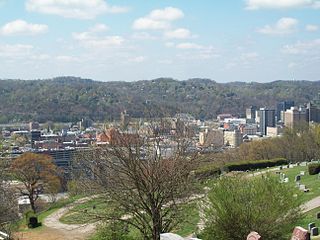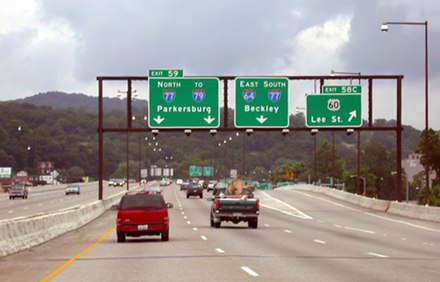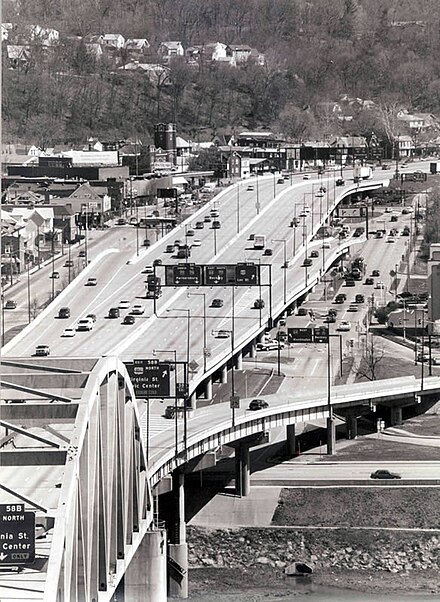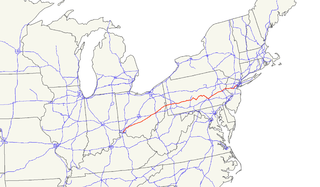
U.S. Route 22 is a west–east route and is one of the original United States highways of 1926, running from Cincinnati, Ohio, at US 27, US 42, US 127, and US 52 to Newark, New Jersey, at U.S. Route 1/9 in the Newark Airport Interchange. US 22 is named the "William Penn Highway" throughout most of Pennsylvania. In southwest Ohio, it overlaps with State Route 3 and is familiarly known as the 3C Highway, "22 and 3", and Montgomery Road.

Interstate 64 (I-64) is an Interstate Highway in the Eastern United States. Its western terminus is at I-70, U.S. Route 40 (US 40), and US 61 in Wentzville, Missouri. Its eastern terminus is at an interchange with I-264 and I-664 at Bowers Hill in Chesapeake, Virginia. I-64 connects the major metropolitan areas of St. Louis, Missouri; Louisville, Kentucky; Lexington, Kentucky; Charleston, West Virginia; Richmond, Virginia; Norfolk, Virginia; and Virginia Beach, Virginia.
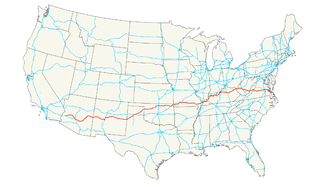
U.S. Route 60 (US 60) is an east–west United States highway, traveling 2,670 mi (4,300 km) from southwestern Arizona to the Atlantic coast in Virginia. Despite the final "0" in its number, indicating a transcontinental designation, the 1926 route formerly ended in Springfield, Missouri, at its intersection with the major US 66. In fact, US 66 was almost given the US 60 number.
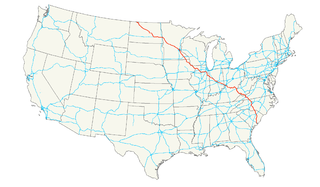
U.S. Route 52 (US 52) is a major United States highway in the central United States that extends from the northern to southeastern region of the United States. Contrary to most other even-numbered U.S. Highways, US 52 primarily follows a northwest–southeast route, and is signed north–south or east–west depending on the local orientation of the route.

U.S. Route 21 (US 21) is a north–south United States Numbered Highway that runs 394 miles (634 km) from Hunting Island State Park, South Carolina to Wytheville, Virginia.
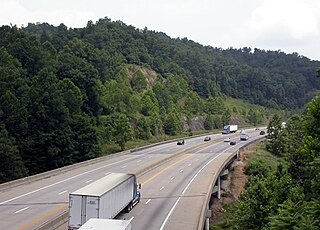
The West Virginia Turnpike is a toll road in the US state of West Virginia. It is also signed as Interstate 77 for its entire length as well as Interstate 64 from Charleston to just south of Beckley. From Beckley, the road extends south to Princeton. The Turnpike contains the only tolled sections of either Interstates 64 or 77.
Interstate 264 (I-264) is an Interstate Highway in the U.S. state of Virginia. It serves as the primary east-west highway through the South Hampton Roads region in southeastern Virginia. The route connects the central business districts of Chesapeake, Portsmouth, Norfolk, and Virginia Beach and serves as the most direct link between those cities and the resort beaches along Virginia's Atlantic coast.
In the United States, Corridor D is part of the Appalachian Development Highway System. It travels from Bridgeport, West Virginia to Cincinnati, Ohio. It travels US 50 for much of its eastern portion. The western portion of road in Ohio is known as State Route 32. ADHS Funding is separate from other Federal Highway funds.

West Virginia Route 622 is a north–south state highway located entirely in Kanawha County, West Virginia. The southern terminus of the route is at West Virginia Route 25 west of Institute. The northern terminus is at Interstate 77 exit 114 north of Pocatalico.

West Virginia Route 114 is a north–south state highway located in the Charleston, West Virginia area. The southern terminus of the route is at U.S. Route 60 east of downtown Charleston. The northern terminus of the route is at Interstate 79 north of Big Chimney.
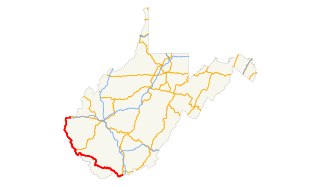
U.S. Route 52 (US 52) skirts the western fringes of the U.S. state of West Virginia. It runs from the Virginia state line near Bluefield, where it is concurrent with Interstate 77 (I-77), in a general northwest and north direction to I-64 at Kenova. There it turns east, overlapping I-64 for five miles (8.0 km) before splitting off onto the West Huntington Expressway into Ohio via the West Huntington Bridge. Despite having an even number, US 52 is signed north–south in West Virginia. In some other states along its route, it is signed east-west. The West Virginia segment is signed such that US 52 north corresponds to the general westward direction of the highway, and vice versa. For a while, US 52 parallels US 23, which is on the other side of the Big Sandy River in Kentucky. This continues into Ohio, where US 52 travels on the Ohio side of the Ohio River while US 23 travels on the Kentucky side.
In the U.S. state of West Virginia, Interstate 77 (I-77) is a major north–south Interstate highway. It extends for 187.21 miles (301 km) between Bluefield at the Virginia state line to Williamstown at the Ohio state line.
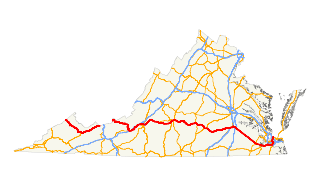
U.S. Route 460 in Virginia runs west-east through the southern part of the Commonwealth. The road has two separate pieces in Virginia, joined by a relatively short section in West Virginia. Most of US 460 is a four-lane divided highway and is a major artery in the southern third of the state.
In the U.S. state of West Virginia, Interstate 64 travels for 184 miles (296 km) passing by the major towns and cities of Huntington, Charleston, Beckley, and Lewisburg.
Corridor Q is a highway in the U.S. states of Kentucky, Virginia, and West Virginia. It is part of the Appalachian Development Highway System and U.S. Route 460. Corridor Q runs from Corridor B near Pikeville, Kentucky easterly to Interstate 81 in Christiansburg, Virginia.
The roads of Huntington, West Virginia include one major interstate highway, two U.S. highways, 6 state routes, and numerous major thoroughfares.

West Virginia Route 817 follows the former path of U.S. Route 35 along the Kanawha River from St. Albans, West Virginia to near Fraziers Bottom, West Virginia and resumes again between near Southside to near Henderson. As such it is actually two separate roads, connected by the 12 mile "gap" in US 35, which will, when US 35 is finished, become WV 817 as well, making the eventual route of the road from St. Albans to Henderson. The route was first signed on October 10, 2008, the day when a new section of US 35 opened to replace this stretch of road. It was extended from Winfield to the current end of the four-lane US 35 near Fraziers Bottom on June 15, 2009 when the section of US 35 that replaced it was opened. The separate section was added on November 1, 2010, when another section of US 35 opened. While US 35 formerly ended at U.S. Route 60, its new path ends at Interstate 64.
